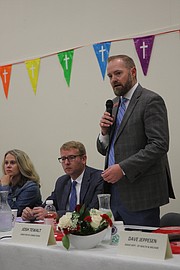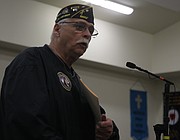Ruling from Rathdrum
In an effort to connect with Idahoans outside the Boise beltway, Gov. Brad Little brought his cabinet to Rathdrum on Thursday as part of his “Capital For A Day” initiative, venturing into Idaho’s small towns to speak and listen to public concerns regarding any and all issues.
“This is a tradition Gov. [Cecil] Andrus started,” Little said. “It was continued by Gov. [Butch] Otter, and it’s a tradition I’m proud to carry forward today.”
Little, eight months into his term, chose to first address the elephant in the room: plans to build a community re-entry center in North Idaho for prisoners being released. The first-term governor received a stack of signatures from local advocates opposing placement of parolees into Kootenai County. He and fellow attendee Josh Tewalt, Idaho’s director of its Department of Correction, addressed the crowd to assuage them of their concerns, with mixed results.
“What that looks like is,” Tewalt explained, “we’re going to put them in a facility near the community where they’re going to return home. That re-entry’s going to be gradual. We’re going to have a lot of accountability around them, but we’re also going to wrap services and treatment and try to address some of those other needs to include helping them find employment, so they can develop resources to provide for their own re-entry. Really, that underlying premise is to help them be successful when they come home to their communities.”
Tewalt added that, while a location for the re-entry facility is still up in the air, the prisoner release is a near-certainty.
“I think that’s the important component to note,” he said. “They are coming home. There is no question. The question is, ‘What does that return look like?’”
Residents prodded for additional information and pushed the re-entry issue further as the day went along, requiring answers to challenging questions, such as who would be liable if a parolee were to attack an innocent bystander.
“With the victims’ rights issue,” Little said, “a lot of those people in that category would never be candidates for the re-entry center. But one of the important things to look at with our corrections system is, the longer people go in and out [of prison], the more skilled they become at becoming violent criminals. We’re trying to break that cycle.”
Not all attendees were opposed to the possibility of Kootenai County serving as a staging ground for prisoners re-entering society.
“My name is David Morgan Lund, and I spent 15 years incarcerated in our prison system,” Lund told the crowd. “We have to come together as a community and help these people return to society. If you treat people like your neighbor, they’ll act like your neighbor. But if you treat people like a pariah, they’re more likely to act like a pariah.”
“We knew the community re-entry center is a big thing,” Little said. “It’s obviously an important issue, and people feel passionate about some of those issues. But what Director Tewalt said was absolutely right. These people will someday be coming home. We need to make sure, when they do come home, we help them integrate back into society the right way.”
The future of parolees was by no means the only topic on the table Thursday.
Little and his cabinet addressed an array of concerns, ranging from economic diversification to the Idaho State Legislature’s attempts to change the initiative process to deficiencies in education.
“I kind of feel like you misled us,” Kootenai County’s Robert White told Idaho Superintendent of Public Instruction Sherri Ybarra. “We were supposed to get rid of Common Core, but you just renamed it Idaho Core. It’s word-for-word Common Core in every way. It’s still here, Common Core. We just heard a lot of testimony about Common Core [in the State Legislature]. What was really sad was we had teachers who quit because they hated Common Core. We had students that committed suicide because of Common Core. We had kids that were mentally put in institutions because of Common Core. We were supposed to get rid of this.”
Residents probed their government leaders throughout the day on timely topics such as a recently introduced bill to ban abortions in Idaho, services for veterans and a push to challenge the belief that local health care professionals can participate in removing children from homes because their parents refuse to vaccinate them.
The spotlight of the day shone on an unexpected star: Mother Nature. Students from Lakeland School District and North Idaho STEM asked about the prospects of re-introducing certain species of frogs back into the state and dwindling wildlife diversity in the region.
Other residents brought up the danger wolves present to local wildlife and humans, proliferating the theory the often-hated predator carries bacteria that can decimate local elk herds and can kill humans by infecting the brain.
“This is always a great opportunity to hear the people and try and understand their needs,” Little said. “It’s a great way to measure the barometric pressure people face up here, and it’s a privilege to serve as a sounding board and better understand what people in North Idaho really need.”
White thanked Little and his entire panel of cabinet members — Superintendent Ybarra included — as he championed the importance of the town hall.
“Sometimes we feel very isolated up here in North Idaho,” he said. “So we thank you all for taking the time to come up here.”





